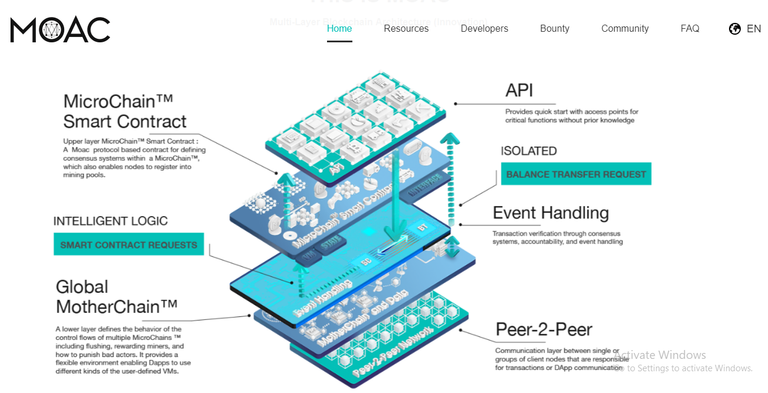The MOAC platform is a multi-blockchain software and deployment service solution for rapid development of decentralized applications (DApps) and smart contracts on a scalable P2P service network. By using an advanced layered architecture for asynchronous smart contracts and a variety of configurable consensus systems (including “proof of work” and “proof of stake”), the MOAC platform enhances existing DApps with additional functionality and scalability solutions.
MicroChains, Smart Contract as MicroChain (SAAM), and Cross-Chains
This borderless approach is further served by “MicroChains,” MOAC’s unique implementation of Sharding
“Different dApps require different use cases, and currently a ‘one size fits all’ blockchain solution does not exist,” said MOAC Chief Business Development Officer Ryan Wang in an interview with the author. “We believe it makes the most sense that, for each of these dApps, there’s a standalone blockchain serving it. With the MOAC architecture, each MicroChain is highly configurable according to the need of each dApp: consensus protocols, number of nodes, block size, block generation frequency.
Multi-Layered Architecture
MOAC seeks to push decentralization beyond the scope of what current infrastructure networks like Ethereum and EOS can offer.
“In a blockchain system like Ethereum, there’s no difference between a balance transfer transaction and a smart contract transaction,” Wang explained. “All the transactions are handled at the global level, thus greatly limiting the TPS and the system-level performance.”
“Balance transfer transactions are important transactions that do not require heavy computation power; however, most smart contract transactions require heavy computation power,” Wang said. “That’s why we introduced a multi-layered architecture — with MOAC, all balance transfer transactions are handled at the bottom PoW [Proof of Work] layer (the MotherChain), and most smart contract transactions are handled at the top layer (MicroChains).”
MOAC also allows network participants to mine from lower-power devices like mobile phones, incentivizing growth for network scalability.
MicroChain Mining
The upper layer of the MOAC platform where a node verifies transactions for smart contracts and other consensus systems. Mining for MicroChains will be rewarded with MOAC tokens and tokens associated with that specific MicroChain.
MotherChain Mining
The lower layer is the Proof of Work MotherChain, which is the foundational layer for data processing and storage. Mining for the MotherChain is how miners can earn the MOAC cryptocurrency.
Wallet and Payment System
The MOAC Platform features a fully functional wallet protocol. This enables MOAC to work with a variety of 3rd party wallet solutions. Any wallet compatible with the MOAC protocol will work smoothly with the platform.
In addition, MOAC is working with the developer community to develop multiple open source web and desktop wallets which will work on platforms such as Windows, Mac, iOS, and Android.
MOAC Token
MOAC’s smart contract system is fully compatible with Ethereum’s EVM system, supporting ERC20 and ERC721 token standards.
The MOAC coins in circulation come from two sources: initial 150 million and mining rewards of the MOAC blockchain. The initial 150 million MOAC coins are distributed as the following: 75 million is used for ICO, 15 million is used for MOAC foundation, 15 million for the team, and 45 million is reserved for development cost. The mining rewards is generated in each block and distributed to the miners.
Find out more on their website: https://moac.io
Read their whitepaper https://www.moac.io/uploads/MOAC_White_Paper.pdf
https://github.com/MOACChain/moac-core

Congratulations @novie-02! You have received a personal award!
Click on the badge to view your Board of Honor.